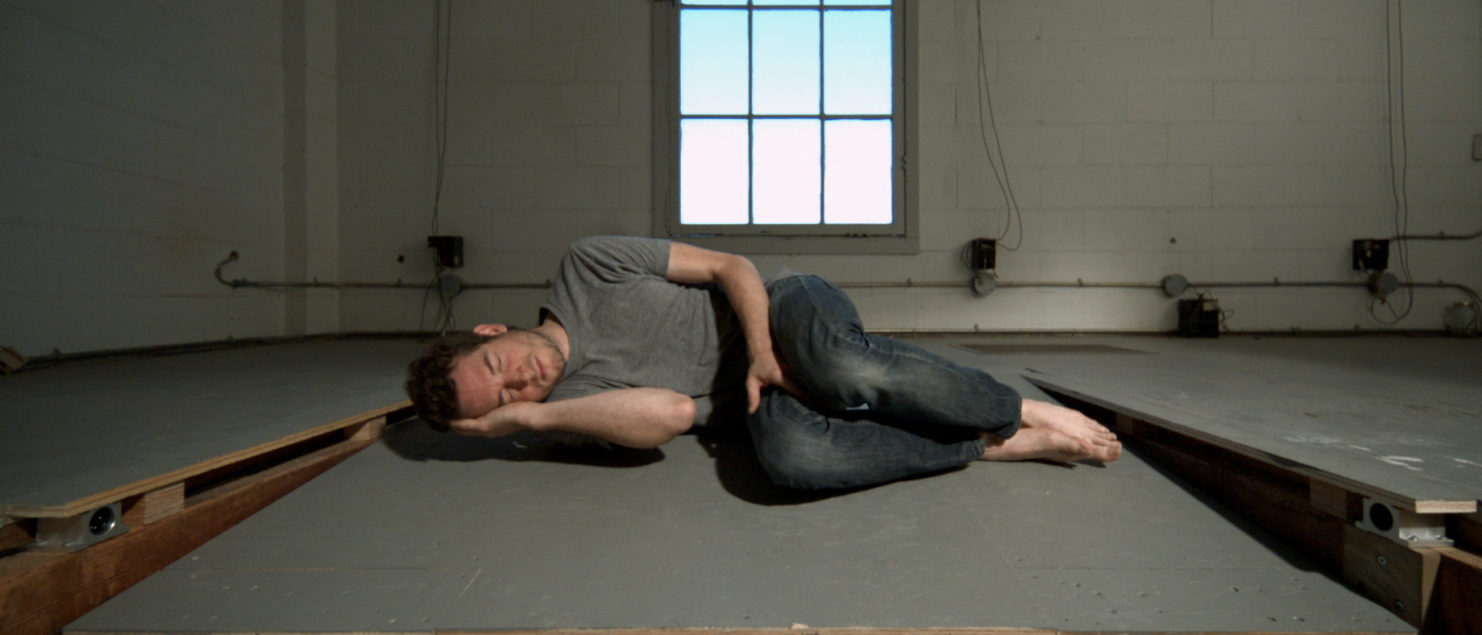A RISKY JUMP: VIDEO OF ARTIST FALLING FINDS SPACE AND TIME IN TIME
Kevin Griffin, The Vancouver Sun
A Risky Jump at Wil Aballe Art Projects is more than a video showing the artist Scott Billings falling in ultra slow motion and coming safely to rest on a crash pad. It’s also an installation that includes the digital and mechanical equipment that projects the image of the artist on the wall. A third part isn’t visible. It’s the space between the projector and the image: it’s activated in a way that I’ve never seen before with a video.
Billings starts out in a fetal position lying on his right side on a wooden platform. His eyes are closed as if asleep. He looks vulnerable and completely unaware of what’s about to happen.
The trap door on which he’s lying gives way and he’s momentarily suspended in air, appearing to levitate. Once fully into his descent, Billings’ whole body becomes intensely expressive: his mouth and eyes open wide and his arms flail out, his left above him and his right sideways. His right hand and arm initially shoot so directly toward the camera it creates an incredible foreshortening. All this happens in ultra slow motion so that every twist and turn is visible.
As Billings falls, the projected image on the gallery wall falls in tandem. It does that because there is a direct relationship between the moving image of Billings falling and the projector. It’s mounted on a 3.9 meter (13 foot) track that runs from the ceiling to floor so it can physically move and follow Billing’s fall to earth.
As I watched A Risky Jump, I found myself looking at both the falling artist and the HD projector on its track. If it had been a stationary projector mounted on the ceiling, for example, I don’t think I would have paid it much attention at all. But because it was moving at the same rate as the falling artist in the video, it created a connection between the image and projector. Instead of there being ‘empty space’ between the source of the image and the image, I found that space became intensely activated. It was ‘filled’ with the relationship between the mechanical/digital and visual. The projector appeared to be a doppelgänger for the body of the artist in the video. It materialized the digital.
You might think that the technical side would overwhelm the emotional experience of the work. It didn’t. The various components on the floor, for example, weren’t hidden in a box. Save any coding that the work required, all the major elements were visible. As the projector finished at the bottom of the cycle, it would pause briefly before rising again to the top.
A Risky Jump has an element of slapstick humour similar to someone slipping on a banana peel. At first, when the artist is shown on his side, he looks as if he’s performing as someone sleeping. The slapstick is the trap door opening and surprising the sleeping artist and waking him up.
The work is a visual pun: the artist doesn’t fall asleep; he is already asleep when it begins. He does the opposite: he falls awake.
At this point, the video changes so that it doesn’t resemble a performance any longer. It becomes more of a record of his fall and of his surprisingly expressive gestures he makes as he braces himself before hitting the crash pad. When he finally reaches bottom and bounces back up, his left foot became so clenched it looked almost feline. In real time, that gesture would likely take place so quickly that it would be missed entirely. But by slowing down the fall, the camera reveals unconscious, involuntary movements.
The video has a dream-like inevitability to it. I knew he was going to fall to the ground every time I watched but all the same, I couldn’t help watching over and over again. I found myself drawn to the unintended choreography of his body as it fell.
What happens to Billings isn’t a literal ‘risky jump’ as the title suggests. The title is from a quote referring to a slow motion camera by pioneering Soviet filmmaker Dziga Vertov mentioned at the start of an essay on Billings’ work by Carla Benzan. “Did a risky jump for a slow motion camera,” Vertov wrote in 1918 adding that while he didn’t recognize his face on the screen, it nonetheless revealed his thoughts and emotions.
One of the qualities that stood out for me in the work was the way it played with time. A Risky Jump manipulates time by slowing it down to epic proportions. In real time, Billings’ fall took less than a second. In the video, the descent is stretched into about five minutes.
A Risky Jump literally expands the moment. By finding space in time and extra time in time, A Risky Jump turns a simplel fall into something much more momentous.
A Risky Jump by Scott Billings continues at Wil Aballe Art Projects until Saturday, April 18

